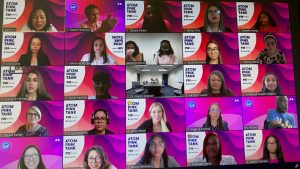 Karlene Cousins |
We all can identify with the challenge of balancing work and life boundaries, especially in today’s computer-powered and increasingly wireless world.
For Karlene Cousins, assistant professor in the Department of Decision Sciences and Information Systems in the College of Business Administration, interest in how people use technology every day evolved into academic research delving into the complexities of managing the ever-shifting boundaries between the professional and personal aspects of modern life.
“When I was living in Atlanta and riding the commuter trains there, I was fascinated by the people at work on nomadic computing devices such as cell phones, personal digital assistants, and laptops,” Cousins said. “I was curious to learn how this behavior pattern affected their personal lives and their work productivity.”
Cousins and a colleague explored this topic in depth in a research report titled “Human Agency in a Wireless World: Patterns of Technology Use in Nomadic Computing Environments” that was published recently in Information and Organization, a leading journal that publishes original scholarly articles that examine the relationships between information technologies and social organization.
Study takes a positive look at how technology is incorporated into the work-life balance.
According to Cousins, discussions around today’s ubiquitous computing environments have spawned concerns about the social impact of technology on work-life boundary issues. However, an initial review of published work-life literature reflected widespread fragmentation in theoretical perspectives, the frequent use of contradictory terms and explanations, and a minor role bestowed to technology. In addition, the prevailing view seemed to be that workers’ growing use of technology and wireless access had a negative effect upon work-life balance.

“We set out to develop a more consistent, theoretical insight into the role that technology plays in the broader work-life context,” Cousins said. “We used a longitudinal, interpretive, multi-case study approach to investigate how mobile workers use nomadic computing environments to manage work-life boundaries successfully. By focusing on effective users, we employed a positive lens and documented positive outcomes.”
What kind of technology user are you?
As part of the research process, Cousins and her colleague categorized their case study interviewees based on the users’ experience and approach to technology, giving them aptly descriptive names such as “Rookie,” “Timenator,” “Top Gun,” “Superwoman,” and “Mr. Gadget.”
These users represent a cross-section of office-based employees, teleworkers, and self-employed workers from multiple industries. Many were interviewed more than once over several months to gain insight into how their use of technology was evolving over a relatively short amount of time.
The study examines a variety of conventional and creative work-life border management strategies, including managing space utilization through multi-tasking and space reconfiguration, negotiating borders, managing accessibility, configuring technologies, and integrating or segmenting technologies according to work or life domains.
Technology integrates with modern life.
Many of the technology users employ techniques with which we are all familiar—everything from using travel or commuting time to catch up on phone calls and email to using distinctive cell phone ring tones to distinguish personal calls from business ones.
In a particularly interesting case study, one highly mobile, self-employed user who is a certified trainer for Microsoft described how he installed wireless networks at the homes of frequently visited family members, even though he would be the only one ever using the technology.
“Many of the users we interviewed felt that the use of the nomadic computing environment promoted balance in work and life,” Cousins said. “Many described how their ability to multi-task and to communicate and collaborate more efficiently through the use of the nomadic computing environment allowed them to be more effective at both work and home. Others felt that it gave them the ability to maximize use of time at work so that more time was available to focus on personal activities.”
Cousins said results also indicated that the blurred boundaries linked to mobile technology use may not be associated with negative consequences and dysfunction, but could instead be evidence of a transition to modern forms of work and life.
Ultimately, the study concludes that the use of the nomadic computing environment to implement border management strategies helps to shape the realms of experiences that comprise work and life and the interaction between the two. In turn, learning how certain outcomes in the effort to balance work and life occur helps shape work-life border management strategies that we all can put into practice in our quest of a more harmonious work-life balance.




